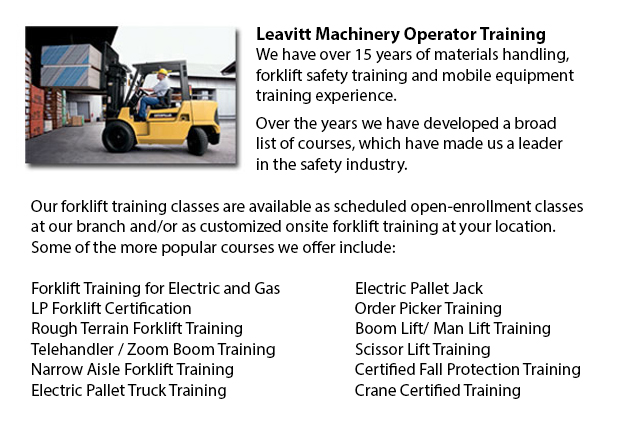
Kitchener Forklift Training Schools - The Advantages Of Taking One Of Our Forklift Training Schools
Are you searching for work as a driver of a forklift? Our regulatory-compliant mobile equipment operator training offers instruction in types of forklifts, pre-shift check, fuel kinds and handling of fuels, and safe operation of a lift truck. Practical, hands-on training helps individuals participating in obtaining basic operational skills. Course content covers current rules governing the utilization of forklifts. Our proven forklift courses are intended to offer training on these types of trucks: counterbalanced forklift, powered pallet trucks and narrow isle forklift.
Do not lower or raise the fork while the lift truck is moving. A load must not extend above the backrest due to the danger of the load sliding back toward the operator. Inspect for overhead obstacles and ensure there is sufficient clearance before raising a load. Stay away from overhead power lines. When the load is raised straight up, tilt it back slightly.
While the load is raised the lift truck will be less steady. Make certain that no pedestrians cross underneath the elevated fork. The operator should never leave the lift truck while the load is raised.
The forks should be level when handling pallets, and high enough to extend all the way into and underneath the load. The fork's width must provide even distribution of weight.
Prior to unloading or loading the truck, set the brakes and chock the wheels. Floors have to be strong enough to support the weight of the forklift and the load combined. Fixed jacks can be installed to be able to support a semi-trailer that is not attached to a tractor. The height of the entrance door must clear the forklift height by a minimum of 5 cm. Mark edges of rail cars, ramps or docks and avoid them.
-
Kitchener Overhead Crane Operator Training
Kitchener Overhead Crane Operator Training - Our overhead crane operator training course is designed to teach employees the basics of overhead crane/sling operation and pre-shift checks. Courses are taught by our expert trainers and consultants. Well... More -
Kitchener Crane Training School
Kitchener Crane Training School - The crane training school offers industry-relevant programs. Courses provide trainees with learning outcomes which match present industry demands. Our small class sizes combine hands-on experience and theory. Our qua... More -
Kitchener Skid Steer Ticket
Kitchener Skid Steer Ticket - The lift arms on the skid-steer loader are located at the side of the driver along with pivots behind the driver's shoulders. These features makes the skid-steer loader different as opposed to the conventional front load... More -
Kitchener Manlift Operator Certification
Kitchener Manlift Operator Certification - Our scissor platform and aerial lift training and certification empowers participants with a knowledge and general understanding of the efficient and safe use of "Power Operated Mobile Work Platforms," under... More -
Kitchener Crane Safety Training
Kitchener Crane Safety Training - Companies and crane operators have to be aware of the problems related to crane safety. Legislation provides rules for the safe operation, inspection and maintenance of lifting machines all around North America. Cran... More -
Kitchener Forklift Training Programs
Kitchener Forklift Training Programs - Are you searching for work as a forklift driver? Our regulatory-compliant mobile equipment operator training offers instruction in kinds of forklifts, pre-shift check, fuel kinds and dealing with fuels, and safe... More -
Telehandler Training in Kitchener
Telescopic handlers often known as telehandlers for short, are an extremely popular piece of heavy construction machinery. They are commonly used in the construction and agricultural industries. These equipments have extreme reaching ability and can... More -
Kitchener Loader Ticket
Kitchener Loader Ticket - Gehl articulated loaders have been made to suit just about any condition. They provide great traction and optimal maneuverability thanks to a heavy-duty oscillating joint that offers 45-degree rotating angles right and left,... More

Forklift Certification Kitchener
TOLL FREE: 1-888-254-6157
Kitchener, Ontario
forkliftcertificationkitchener.com
Email Us
About Us


